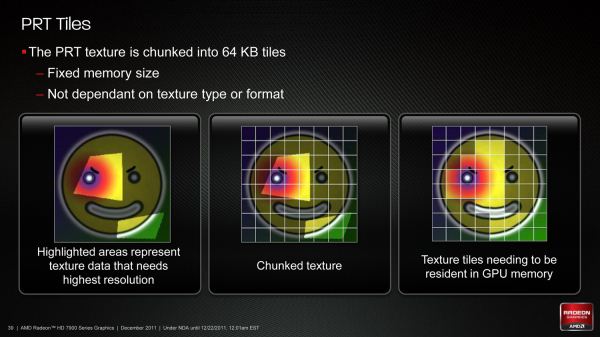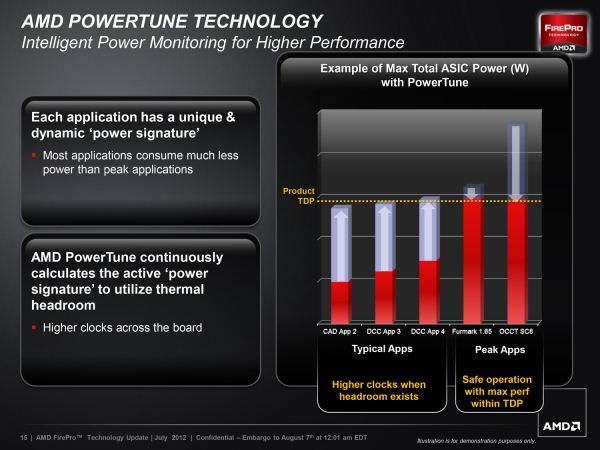The AMD FirePro W9000 & W8000 Review: Part 1
by Ryan Smith on August 14, 2012 4:00 AM ESTThe Rest of the FirePro W Series Feature Set
So far we’ve spent quite a bit of time talking about the FirePro W series in reference to AMD’s GCN architecture. Without question GCN is the single biggest change coming from AMD’s past products, but GCN is but one component of the Southern Islands family of GPUs that are the underpinning of this generation of AMD GPU products. Much like we’ve already seen on the desktop side of things there are a number of additional features Southern Islands brings with it that have some specific relevance in the professional graphics market.
Perhaps the single biggest improvement is that Southern Islands finally introduces full Error Correcting Code (ECC) memory support. In prior generations of GPUs AMD did not have any ECC support, with the closest thing being Error Detection & Correction (EDC), which could detect errors introduces across the memory bus (a very real concern with high-speed GDDR5) but no other type of errors. This admittedly isn’t a huge concern for the graphics workloads that past generations of FirePro specialized in, but moving forward for compute workloads it’s a critical feature due to the impact of errors.
So starting with the FirePro W series AMD will have full ECC support in selected models. This will include both ECC for internal SRAM caches (which is actually a free operation), and ECC for the external VRAM (accomplished through the use of a virtual ECC scheme). This functionality is going to be limited to products based on the Tahiti GPU, which means the W9000 and W8000. As Tahiti is AMD’s only GPU specifically configured for maximum compute performance, this comes as no great surprise. Consequently, the Pitcarin based W7000 and W5000 will have no such ECC support, mirroring their lower compute performance and emphasis on graphics.
Moving on, it came as a bit of a surprise to see AMD tout their Partially Resident Texture technology as a FirePro feature. We’re accustomed to thinking of PRT as a gaming technology – particularly due to the id Software Megatexture technology – but AMD tells us that it should be applicable to any kind of application using a large data set. More importantly however is the fact that since PRT can only be accessed under OpenGL right now, it’s far more accessible to professional graphics applications (which almost exclusively use OpenGL) as opposed to games and their heavy reliance on Direct3D. In any case we aren’t going to go into great detail about this technology since we’ve covered it before, but it should be interesting to see if AMD’s predictions are right.
Meanwhile, PowerTune marks its return on the FirePro W series. PowerTune, as you may recall, is AMD’s power throttling technology which is responsible for reining in on video card power consumption to keep it below a desired level. AMD has had PowerTune since the last-generation Cayman GPU, but it was only available on that GPU, meaning it wasn’t available on AMD’s top-tier FirePro cards such as the V9800. With The FirePro W series it’s finally available across AMD’s entire lineup, marking the first time it’s available to products like the W7000 and W5000. Given the latter’s sub-75W TDP, PowerTune is going to play an especially important role in making that possible.
Also seeing its introduction in Southern Islands and by extension the FirePro W series is PCI-Express 3.0 support. PCIe 3.0 doubles the effective transfer rate for a PCIe x16 slot to 16GB/sec in each direction, up from 8GB/sec in PCIe 2.0. This won’t make much of a difference for graphics workloads since they rarely consume 8GB/sec in the first place, but for compute workloads this is a critical feature. Any compute workloads that need to constantly send large amounts of data back and forth between the CPU and GPU should significantly benefit from this.
Finally, in another unexpected feature mention within AMD’s marketing materials, AMD is taking the time to mention their Video Codec Engine (VCE) hardware H.264 encoder, which was also introduced in Southern Islands. Both AMD and NVIDIA have been taking the time to mention their hardware video encoders in their respective professional graphics cards, which is unexpected given the fact that these hardware encoders are primarily intended for consumer uses such as quick video transcoding and video conferencing; neither encoder is up to the task of broadcast/archival quality video. Nevertheless, while neither company seems to have a solid idea of what to do with the hardware in the professional market, they’re throwing it out there in order to see what their customers can come up with.












35 Comments
View All Comments
damianrobertjones - Tuesday, August 14, 2012 - link
Over the years I've always popped over to this page to read the latest news and especially articles yet over the last year, or maybe a bit more, the articles haven't exactly been flowing. is the site slowing down?:(
bobsmith1492 - Tuesday, August 14, 2012 - link
This engineer doesn't like the so-called "professional" cards. I think they are a rip-off. My high-end workstation computer came with a top-of-the-line Quadro and it could barely handle a second monitor. I finally got a mid-level gaming card and was much happier with its performance.A5 - Tuesday, August 14, 2012 - link
Then the card you got was broken. Even integrated graphics can handle 2D on 2 displays no problem.bobsmith1492 - Wednesday, August 15, 2012 - link
That's what I would have thought, but no. Even scrolling down an Excel document was slow, pausing every second to redraw the whole screen. Same thing when dragging a window around over a background that was "stretch to fit." Garbage! Tried modifying graphics settings, hardware acceleration on/off, Googling like mad, posts in the AT forums but no-go.wiyosaya - Tuesday, August 14, 2012 - link
100 percent agree with your assessment that the pro cards are a rip off. The chips are the same chips as in gaming cards. The only difference is a few switches in firmware that cut off options when run in gaming cards.That firmware is also developed by the same developers; I say this after having worked in a similar field where the company I worked for marketed RIP software designed to print to copiers. All the features were in the software, but customers had to pay sometimes substantially extra to enable some of those features. In my opinion, anyone who thinks that there is a separate team developing "pro" drivers is mistaken.
With a PC that has enough processing power, IMHO, most professionals will not need the "extra capabilities" that the pro cards offer over gaming cards. Perhaps the only reason a pro would need a pro card, if you believe the marketing coming out of the pro card realm, is because you are working with a model that has thousands of parts.
However, there is a recent trend to kill double precision compute power in gaming cards. IMHO, this is going to hurt graphics card makers more than it will help. It was for this reason that I avoided buying a GTX 680 and opted for a 580 instead for a recent build of mine.
nathanddrews - Tuesday, August 14, 2012 - link
Apparently it doesn't hurt them at all since they're making a lot of money with pro cards. All you have to do is show this to a CAD designer and you'l make sale:http://vimeo.com/user647522
aguilpa1 - Wednesday, August 15, 2012 - link
All these videos illustrate is that certain hardware accelerated features are turned off at the bios and software level. It is an illustration of intentional vender modifications of a piece of hardware to differentiate the two in order to improve the profit of the other.This was clearly illustrated in early versions of Quadros whereby a simple bios update would re-enable the turned off features of the consumer model. These methods may have been disabled by now by the vendor as they get wise to the ways of gamers.
rarson - Tuesday, August 14, 2012 - link
Wrong. With a professional card, you pay for both the validation and the software, neither of which are professional quality in the consumer variants."That firmware is also developed by the same developers"
Firmware and drivers are two different things, by the way.
wiyosaya - Thursday, August 16, 2012 - link
"Wrong. With a professional card, you pay for both the validation and the software, neither of which are professional quality in the consumer variants."The marketing departments have done their jobs very well or you are "pro vendor shill," IMHO as that is what the vendor wants everyone to think. As I previously stated, having been in more than one position where the companies that I worked for sell "professional" software, it is not the case.
I expect that most pro software packages will run on most gamer cards with very little difference except, perhaps, when pushing the pro software package to its absolute limit. If anyone wants to pay $4K for a $400 card, they are certainly welcome to do that. IMHO, it is a complete waste of money.
PrinceGaz - Sunday, August 19, 2012 - link
If you really are a professional graphics (or compute) user and would rather take the chance by opting for a non-validated $400 card instead of a fully-validated and backed by the hardware and software-vendor $4,000 card, then you have got your priorities wrong. That or you're being seriously underpaid for the sort of work you are doing.Your software vendor isn't going to be very impressed when you report a problem and they find the system you are running it on has a GeForce or Radeon card instead of one of the validated professional cards and driver versions supported by it!